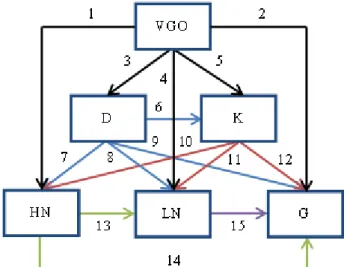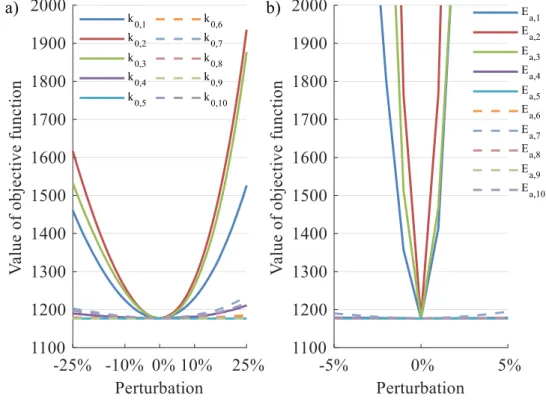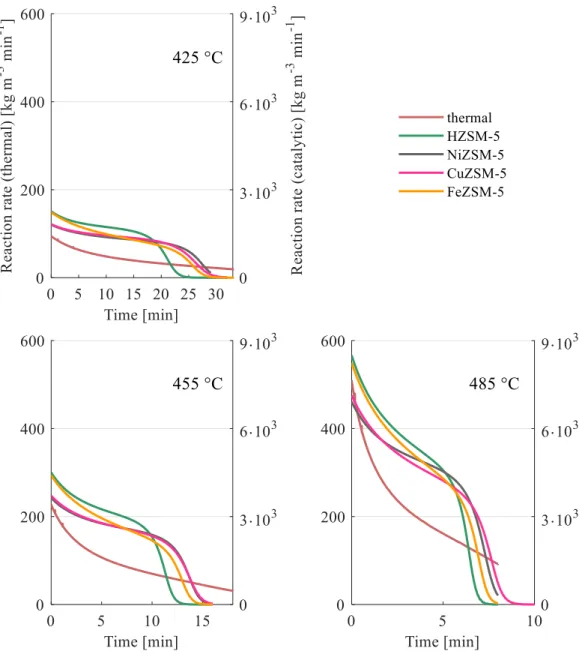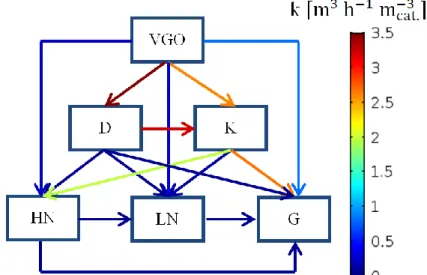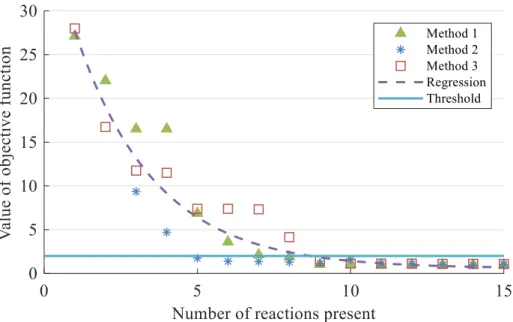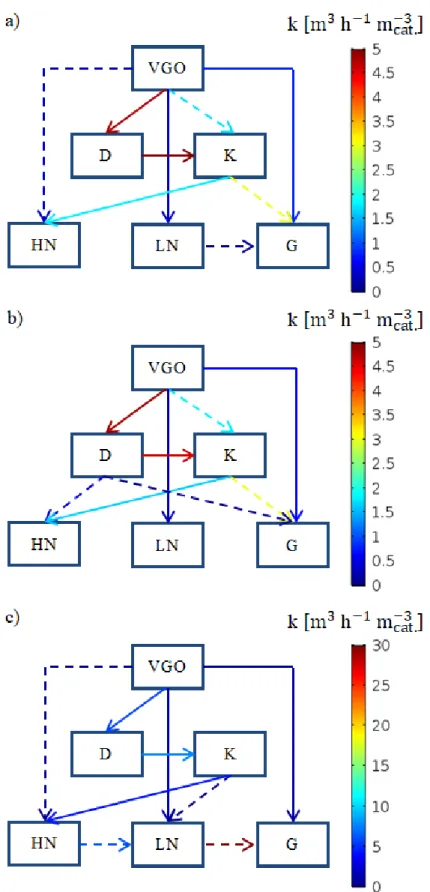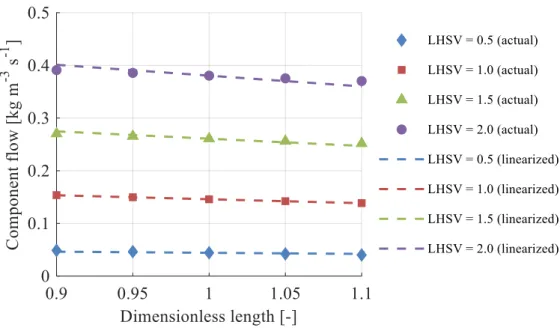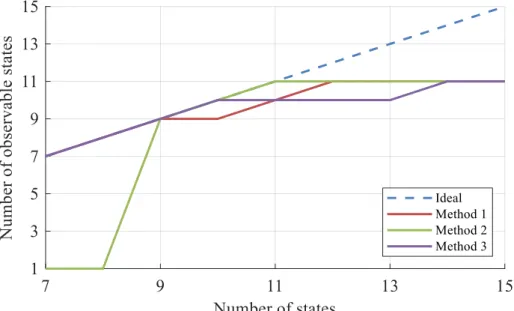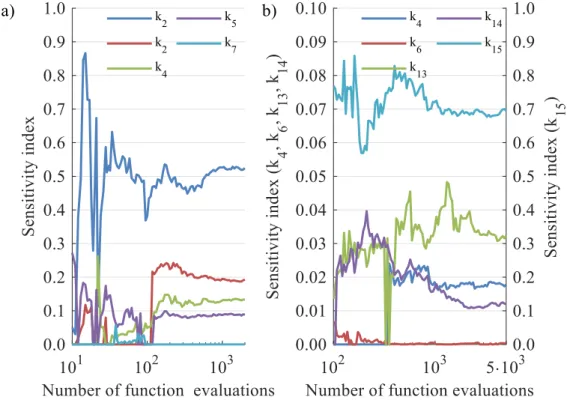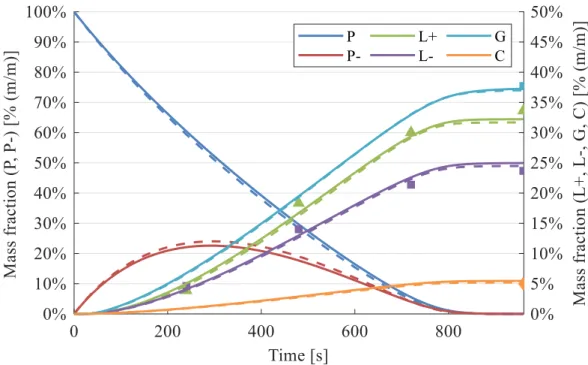DOCTORAL (PhD) THESIS
ZOLTÁN TILL
University of Pannonia
2020
University of Pannonia
Institute of Chemical and Process Engineering
Advanced Methods in the Design
of Heterocatalytic Processes under Uncertainties
DOCTORAL (PhD) THESIS
Zoltán Till
Supervisors:
Dr. Tibor Chován, associate professor Dr. Tamás Varga, associate professor
Doctoral School of Chemical Engineering and Material Sciences University of Pannonia
2020
DOI:10.18136/PE.2020.763
Advanced Methods
in the Design of Heterocatalytic Processes under Uncertainties Thesis for obtaining a PhD degree in the Doctoral School of Chemical
Engineering and Material Sciences of the University of Pannonia in the branch of Bio-, Environmental and Chemical Engineering Sciences
Written by Zoltán Till
Supervisors: Dr. Tibor Chován, Dr. Tamás Varga
propose acceptance (yes / no) ……….
……….
(supervisors) As a reviewer, I propose acceptance of the thesis:
Name of Reviewer: …...…... yes / no
……….
(reviewer) Name of Reviewer: …...…... yes / no
……….
(reviewer)
The PhD-candidate has achieved …...% at the public discussion.
Veszprém, ………. ……….
(Chair of Committee) The grade of the PhD Diploma …... (…….. %)
Veszprém, ………. ……….
(Chair of UDHC)
“Beware of the man who works hard to learn something, learns it, and finds himself no wiser than before,” Bokonon tells us. “He is full of murderous resentment of people who are ignorant without having come by their ignorance the hard way.”
(Kurt Vonnegut: Cat’s cradle)
Abstract
Advanced Methods in the Design of Heterocatalytic Processes under Uncertainties
All kinetic models are uncertain to some extent. Usually that is the case when many consecutive and competitive reactions occur in the system investigated. In such cases, determining individual reaction rates with high accuracy becomes ever less feasible. The kinetic parameter identification problem will be even more complicated if the reaction mixture contains an extensive range of individual species, and there are not enough resources (available analytical methods or time, which is also important in the engineering practice) available to measure the concentration of every component.
Nevertheless, engineers would even want to use uncertain kinetic models to size key pieces of equipment for the industrial implementation of the chemical process. And in order to counter the possible effects of uncertain parameters, these units tend to be oversized. Although this is viable, it would be economically more efficient if we had higher confidence in the kinetic parameters.
Consequently, this dissertation revolves around novel and improved methods to reduce uncertainties connected to reaction networks describing various heterocatalytic processes. Specifically, I authored new kinetic parameter identification methods, applied global sensitivity analysis and the concept of Factors Fixing to reduce the number of parameters to be identified from a series of measurements with a given level of detail, and mapped out the correlations between the formations of certain components that also reduces the number of independent reactions in the system.
Moreover, there are two case studies present in the second part of the dissertation that deal with the optimal design of heterocatalytic processes; the first one aims to answer the question of the optimal design itself, while the second one addresses the broader topic of design under uncertainties (including the uncertainties of reaction networks, or catalyst deactivation) and how we can take these into account when designing a reactor, aside from and possibly without much oversizing.
Kivonat
Továbbfejlesztett módszerek heterogén katalitikus folyamatok bizonytalanságának csökkentésére
Minden kinetikai modell valamilyen mértékű bizonytalansággal terhelt.
Általában ez a helyzet áll fent akkor, ha nagyszámú konszekutív és kompetitív reakció játszódik le a vizsgált rendszerben. Ebben az esetben az egyes reakciók sebességének pontos meghatározása egyre kevésbé kivitelezhető. A kinetikai paraméterek identifikálásnak feladata még összetettebbé válik, ha a reakcióelegy sokkomponensű és ezzel egyidejűleg nem áll rendelkezésre elegendő erőforrás (analitikai módszer, illetve idő, mely szintén lényeges a mérnöki gyakorlatban) az elegyet alkotó összes komponens koncentrációjának meghatározására.
Mindezek ellenére a mérnöki munka során a bizonytalansággal terhelt kinetikai modellek is felhasználásra kerülnek fontos műveleti egységek méretezése, illetve az adott kémiai folyamat ipari mértékű implementálása során. A bizonytalan paraméterek lehetséges negatív hatásainak kiküszöbölése érdekében ezeket a műveleti egységeket általában túlméretezik. Bár ez járható út a tervezés során, gazdaságilag előnyösebb a kinetikai paraméterek megbízhatóságának növelése.
Ezt a felismerést követve dolgozatomban a heterokatalitikus folyamatokat leíró reakcióhálózatokat övező bizonytalanságok csökkentésére irányuló új és általam továbbfejlesztett módszereket mutatok be. Új módszereket dolgoztam ki a kinetikai paraméterek identifikálására, a globális érzékenységvizsgálat és paraméter rögzítés módszerét alkalmaztam az identifikálandó paraméterek számának csökkentésére adott részletességű mérési adatsorból, valamint feltártam az egyes komponensek képződése közötti korrelációkat, ezzel tovább csökkentve a meghatározandó paraméterek számát a vizsgált rendszerben.
Ezeken túlmenően a dolgozat második részében két esettanulmány kapott helyet, melyek a heterokatalitikus folyamatok optimális tervezésével foglalkoznak, melyek közül az első célja egy heterokatalitikus reaktor optimális tervezése, míg a második a bizonytalanság alapú tervezés tágabb témakörét érinti (ideértve a reakcióhálózatokat, vagy a katalizátor dezaktiválódását övező bizonytalanságokat), bemutatva, hogyan vehetőek ezek figyelembe a reaktor tervezés során, elkerülve a műveleti egység komolyabb túlméretezését.
Auszug
Fortschrittliche Methoden bei der Entwicklung heterokatalytischer Prozesse unter Unsicherheiten
Alle kinetischen Modelle sind bis zu einem gewissen Grad unsicher. In der Regel ist dies der Fall, wenn viele aufeinander folgende und konkurrierende Reaktionen im untersuchten System auftreten. In solchen Fällen wird die Bestimmung der Geschwindigkeiten der individuellen Reaktionen mit hoher Genauigkeit immer weniger durchführbar. Das Problem der kinetischen Parameteridentifikation wird noch komplizierter, wenn das Reaktionsgemisch ein umfangreiches Spektrum einzelner Arten enthält und es nicht genügend Ressourcen (verfügbare analytische Methoden oder Zeit, die auch in der Ingenieurpraxis wichtig ist) zur Messung der Konzentration jeder Komponente zur Verfügung stehen.
Dennoch werden sogar ungewisse kinetische Modelle zur Dimensionierung wichtiger Anlagen für die industrielle Umsetzung des chemischen Prozesses durch die Ingenieure verwendet. Und um den möglichen Auswirkungen unsicherer Parameter entgegenzuwirken, sind diese operativen Einheiten meist überdimensioniert. Obwohl dies lebensfähig bei der Planung ist, ist es wirtschaftlich effizienter, die Zuverlässigkeit der kinetischen Parameter zu erhöhen.
Folglich zeige ich in meiner Arbeit neuartige und verbesserte Methoden, um Unsicherheiten im Zusammenhang mit Reaktionsnetzen zu verringern, die verschiedene heterokatalytische Prozesse beschreiben. Insbesondere habe ich neue kinetische Parameter-Identifikationsmethoden, eine globale Sensitivitätsanalyse und das Konzept von Faktoren entwickelt, die die Anzahl der Parameter verringern, die aus einer Reihe von Messungen mit einem bestimmten Detailgrad identifiziert werden sollen. Ferner deckte ich die Korrelationen zwischen den Formationen bestimmter Komponenten auf, die auch die Anzahl unabhängiger Reaktionen im System reduzieren.
Außerdem gibt es zwei Fallstudien im zweiten Teil der Studie, die sich mit der optimalen Gestaltung heterokatalytischer Prozesse befassen. Die erste soll die Frage nach dem optimalen Design selbst beantworten, während die zweite das weiter gefasste Thema Planung unter Unsicherheiten (einschließlich der Unsicherheiten von Reaktionsnetzen oder Katalysatordeaktivierung) erörtert und aufzeigt, wie wir diese bei der Konstruktion eines Reaktors berücksichtigen können, ohne die operative Einheit erheblich zu überdimensionieren.
Table of Contents
List of Notations ... 1
1 Introduction ... 7
2 Theoretical background ... 11
2.1 Heterocatalytic reactions ... 11
2.1.1 Plastic waste pyrolysis ... 12
2.1.2 Vacuum gas oil hydrocracking... 14
2.1.3 Recycling HCl into chlorine via oxidation: the Deacon process .. 15
2.2 Discrete lumping ... 17
2.3 Uncertainties in reactor design ... 20
2.3.1 Optimal design criteria of a fixed-bed HCl oxidation reactor... 21
2.3.2 Design of a VGO hydrocracking reactor under uncertainties ... 24
2.4 Reducing the uncertainties in lumped reaction networks ... 28
2.4.1 Ensuring observability ... 29
2.4.2 Application of Global Sensitivity Analysis (GSA) ... 30
2.4.3 Accounting for correlations in the reaction network... 32
2.4.4 Applying multiple algorithms for parameter identification ... 35
3 Reactor models ... 39
3.1 Dynamic model of a pyrolysis batch reactor system ... 39
3.1.1 Experimental setup ... 40
3.1.2 Reactor model ... 42
3.2 Steady-state plug flow reactor model for VGO hydrocracking ... 47
3.3 Extended model for VGO hydrocracking with H2 consumption ... 49
3.4 Model of a steady-state single tube reactor for HCl oxidation ... 52
3.5 A few-step kinetic model for ethane pyrolysis (ETP) ... 53
4 Kinetic identification of plastic waste pyrolysis on zeolite-based catalysts . 57 4.1 Identification strategy... 57
4.2 Reliability of the identified kinetic parameters ... 62
4.3 Performance of the identified parameters ... 64
4.4 Comparing the various zeolite-based catalysts ... 68
4.5 Chapter summary ... 72
5 Identification and observability of lumped kinetic models ... 73
5.1 Identification strategies... 73
5.2 Performance of the reaction network reduction algorithms ... 79
5.3 Observability of the reaction networks ... 84
5.4 Chapter summary ... 90
6 Reduction of lumped reaction networks using global sensitivity analysis .... 91
6.1 Choosing the right number of samples ... 91
6.2 Case study 1: thermo-catalytic pyrolysis ... 94
6.3 Case study 2: VGO hydrocracking ... 98
6.4 Comparison of GSA methods ... 102
6.5 Effectiveness and performance ... 103
6.6 Chapter summary ... 107
7 Structure of lumped reaction networks with correlating parameters ... 109
7.1 Revisiting the pyrolysis reactor network (P-N0-R10) ... 109
7.2 First alternative reaction network (P-N1-R5) ... 113
7.3 Second alternative reaction network (P-N2-R9) ... 117
7.4 Simplification of the experimental work ... 121
7.5 Chapter summary ... 123
8 Kinetic identification problems and different optimization algorithms ... 125
8.1 Investigated kinetic models ... 125
8.2 The optimization target ... 126
8.3 Identification methods ... 129
8.4 Reaching the optimization target ... 132
8.5 The importance of model reduction ... 135
8.6 Differences between the identified kinetic parameters... 136
8.7 Chapter summary ... 138
9 Optimal temperature profile of a fixed-bed heterocatalytic reactor ... 139
9.1 The reactor design problem ... 140
9.2 Optimization strategy ... 141
9.3 Maximizing HCl conversion ... 141
9.4 Optimizing reactor temperature profile ... 143
9.5 Chapter summary ... 151
10 Uncertainties of lumped reaction networks in reactor design ... 153
10.1 Conventional design method ... 153
10.2 Stochastic design method ... 156
10.3 Conventional design results ... 158
10.4 Reactor sensitivity to uncertain parameters ... 160
10.5 Stochastic design results and comparison ... 162
10.6 Robustness of reactor design ... 163
10.7 Chapter summary ... 167
11 Final remarks and farewell ... 169
Theses ... 173
Publications related to theses ... 176
Articles in international journals ... 176
Articles in conference publications ... 177
Conference abstracts ... 178
Publications not related to theses ... 179
Articles in international journals ... 179
Articles in Hungarian journals ... 179
Articles in conference publications ... 179
Conference abstracts ... 179
References ... 181
Appendix ... 215
List of Figures ... 259
List of Tables... 267
Acknowledgement... 273
List of Notations
Mathematical symbols
a Catalyst Dilution Coefficient [-]
A Cross-section [m2]
c Concentration [kg m-3] or [mol m-3] cp Specific Heat Capacity [J kg-1 K-1]
d Diameter [m2]
du Uncertainty Distance Ea Activation Energy [J mol-1] exs existence variable [-] (Eq. (5.2)) f friction factor [-]
F molar inflow rate [kmol s-1] k Reaction Rate Coefficient [varies]
k0 Pre-exponential Factor [same as k]
K Adsorption Equilibrium Constant [varies]
l Length [m]
ℓ Dimensionless Length [-]
L Kirchhoff Matrix of the Reaction System
Lr Reactor Length [m]
mr Reactant Mass [kg]
𝑚̇ Mass Flow [kg s-1] M Molar Weight [kg mol-1]
n Molar Mass [mol]
N Number of Observations
p Pressure [Pa]
Q Adsorption Activation Energy [kJ mol-1] r Reaction Rate [kg m-3 s-1] or [mol m-3 s-1] r’ Reaction Rate in Volume [kg s-1]
R Gas Constant; R = 8.314 J mol-1 K-1
Rc Component Source [kg m-3 s-1] or [mol m-3 s-1] 𝑅𝑐′ Component Source in Volume [kg s-1]
Si Sensitivity index
t Time [s]
T Reactor Temperature [°C] or [K]
ToS Catalyst Time-on-Stream [h]
v Plug Flow Velocity [m s-1]
𝓋 Dimensionless Velocity [h-1]
V Volume [m3]
𝑉̇ Volume Flow [m3 s-1] w weight fraction [-]
x Mole Fraction [-]
x Search Variable Vector Greek letters
α Decay Coefficient of Catalyst Deactivation [h-1]
δ variation of the total molecular number in the reaction [-] (Eq.
(2.2))
ΔrH Heat of Reaction [J kmol-1]
εref Volume Ratio of the Catalyst and the Reference Phase [-] (Eq.
(3.5))
ε’ Catalyst Volume Fraction [mcat3 mreactor−3 ] η Catalyst Effectiveness Factor [-]
κ Total Heat Transfer Coefficient [W m-2 K-1] ν Stoichiometric Coefficient
ρ Density [kg m-3]
φ Catalyst Activity Coefficient (as a function of time) [-]
Components
DME Dimethyl Ether
HDPE High-Density Polyethylene LDPE Low-Density Polyethylene
PE Polyethylene
PP Polypropylene
PVC Polyvinyl Chloride
ZSM-5 Zeolite Socony Mobil–5; an aluminosilicate zeolite belonging to the pentasil family of zeolites. The additional leading chemical symbol in the abbreviation corresponds to the ion occupying the zeolite ion-exchange sites.
Pseudocomponents
C Coke
D Diesel
G Gas
HN Heavy Naphtha
K Kerosene
L+ Heavy Liquid
𝐿+𝑖 Heavy Isomer
𝐿+𝑜 Heavy Olefin 𝐿+𝑝 Heavy Paraffin
L– Light Liquid
𝐿−𝑖 Light Isomer 𝐿−𝑜 Light Olefin 𝐿−𝑝 Light Paraffin
LN Light Naptha
P Polymer
P– Cracked Polymer
VGO Vacuum gas Oil
Nonlinear Programming
eSS Enhanced Scatter Search
GA Genetic Algorithm
LB Lower Bound of Search variable MINLP Mixed-Integer Nonlinear Programming NLP Nonlinear Programming
NOMAD Nonlinear Optimization with Mesh Adaptive Direct Search PSwarm Particle Swarm Pattern Search
UB Upper Bound of Search Variable
For non-frequently used algorithm abbreviations, refer to Table 8.4.
Abbreviations
CDF Cumulative Distribution Function DAEM Distributed Activation Energy Model DTG Differential Thermogravimetry
EET Elementary Effects Test (Morris Method) ELV End-of-Life Vehicle
FAST Fourier Amplitude Sensitivity Analysis GC-MS Gas Chromatography – Mass Spectrometry GHSV Gas Hourly Space Velocity [h-1]
GSA Global Sensitivity Analysis
LHSV Liquid Hourly Space Velocity [h-1] MPC Model Predictive Control
NMR Nuclear Magnetic Resonance (Spectroscopy) PAWN Pianosi-Wagener Sensitivity Analysis
PDF Probability Distribution Function RMSE Root Mean Squared Error
RS-HDMR High Dimensional Model Representation with Random Sampling STD Standard Deviation
SAFE Sensitivity Analysis for Everybody (Toolbox) TBP True Boiling Point
TGA Thermogravimetric Analysis
VBSA Variance Based Sensitivity Analysis
For identifiers of the different lumped reaction networks introduced in the thesis, refer to Table S1 in the Appendix.
Subscripts
act actual value
B catalyst bed
cal calculated
cat catalyst
comp component
exp experimental
g gas
i ith reaction
max maximum value
min minimum value
pt data point
r reactor
ref reference volume Superscripts
in inflow
j jth reactor
k kth catalyst layer (3.22)
n normalized value
net net amount
out outflow
1 Introduction
A process model is a set of equations, and the necessary input data to solve those equations as well that allows us to describe the behavior of a chemical process system [1]. Needless to say, these two components have to be carefully balanced. We can cleverly set up a sophisticated model that would mimic the behavior of the system investigated as carefully as possible with high algorithmic efficiency; it would be all for nothing if we are not able to fetch the necessary quantity and quality of input data to validate it. Sometimes we have to get on with what we have. For example, interim measurements are usually not exactly detailed. They do not need to be in order to run the plant smoothly. With that in mind, we could say that simpler models have their own raison d’etre. And if that is the case, there ought to be methods that exist to construct process models that are both simple and reliable, i.e., to reduce the uncertainties enveloping them.
After laying the necessary theoretical foundations, I will start with kinetic models, carefully examining the topic of how to represent a complex reaction mechanism with less (here I mean very few) reactions without actually losing the reliability of the kinetic model. For this topic, I have chosen examples of heterocatalytic processes in connection with sustainable development. For example, it is becoming increasingly urgent to do something with the tremendous amount of plastic waste that our civilization currently leaves behind. Among other things, we can utilize pyrolysis to recover valuable fuels and energy storage materials from this waste. On the other hand, the thermo-catalytic cracking of the feedstock polymer leads up to thousands of reactions that are quite a pain in the neck to follow individually. A similar example is the catalytic cracking of long hydrocarbons to produce fuels. The source material in this case can be vacuum gas oil in order to make better use of a barrel of crude oil, thus reducing excess emission; moreover, non-conventional feedstocks (like vegetable oils) can also be processed using such methods.
One of my main objectives is to construct reliable lumped reaction networks.
By their very nature these models tend to have uncertain parameters. Considering that we replace thousands of chemical compounds and reactions with a few lumped ones, this is a plausible assumption. The uncertainty of the kinetic model
is not necessarily related to the model error. Strictly speaking, the latter represents the error between the output of the model and the modeled system. This can be reasonably low even in the case where the values of the model parameters cannot be identified with high certainty. In the specific case, this will mean that even if the difference between the experimental and calculated product composition is reasonably low, it will remain uncertain how many reactions form the lumped reaction network and what are the values of the corresponding kinetic parameters.
Such a situation inevitably decreases our confidence in the kinetic model.
Therefore, I propose different methods in my thesis to reduce the emerging uncertainties. I account for observability and identifiability, correlations between the rates of parallel and consecutive reactions, or apply sensitivity analysis to eliminate the less significant reactions under the specific conditions. I also deal with the problem of the identification of the parameters of the reaction networks that usually involve the application of a nonlinear optimization program;
nevertheless, I would like to show that this is also not an obvious step, associated with uncertainties that can be reduced.
The second major topic of my thesis work broadens the score and discusses the uncertainty factors involved with the design of heterocatalytic processes themselves. The main objective here is to counter the effects of uncertainties in the design procedure, facilitating the applicability of the process model during reactor design and scale-up. On the one hand, I will carry on the knowledge acquired in constructing simplified reaction networks to describe complex processes, and using that as a starting point I would like to address other sources of uncertainties emerging during the design of a hydrocracking reactor, providing an integrated framework to induce robustness. Or, in other words, to fashion a reactor whose operation is the least susceptible to the changes of the possible uncertain parameters. On the other hand, moving away from the problem of simplified reaction networks, I will also investigate the design of a fixed-bed reactor for HCl oxidation using CeO2−CuO/Y catalyst, showing that even such a system with only one reaction between four gaseous compounds could present a challenge of how the optimal reactor design can be defined. In addition to being a simpler reaction system, the choice of HCl oxidation to further investigate was
also motivated by sustainable development as this process is essential to close the production cycle of isocyanates. As the technology otherwise would involve manufacturing a high amount of chlorine from salt brine by consuming insane amounts of electricity, and the Cl2 in turn would end up as an HCl side product that should be somehow processed as well, this oxidation step turning HCl back to chlorine is essential to keep the production of isocyanates sustainable.
With the wide range of process examples, I would like to provide a convincing argument regarding the proposition of the application of the methods I developed to reduce the uncertainties emerging during the modeling of heterocatalytic processes, illustrating both their applicability and the advantages of their application.
This introduction, like any other, is already too long. Without stretching it any further, let us get into the merits!
2 Theoretical background
This thesis involves studying various heterocatalytic reactions, namely the catalytic oxidation of HCl into Cl2 (the so-called Deacon process), vacuum gas oil (VGO) hydrocracking, and plastic waste pyrolysis (in case of the latter the exclusively thermal process is also part of the investigation; although this is not an essential consideration in the long run). I provide a brief introduction to these processes in Section 2.1.
Hydrocracking and pyrolysis are not single heterocatalytic reactions but rather involve so many individual reactions that it often becomes a thorn in one’s side to model them individually. Fortunately, the well-proven lumping methods can come in handy here; I discuss the more common of these in Section 2.2.
The application of discrete lumping is really straightforward; nevertheless, it involves some simplifications that can backfire if we apply it carelessly as the parameters of the reaction network become uncertain. And here comes the core of this thesis, namely how we can reduce the various uncertainties involving these lumped reaction networks. I will introduce various reduction methods in Section 2.4.
Before that, Section 2.3 deals with the heterocatalytic reactors themselves, involving the development of tools and methods to design such reactors, including the choice of the objective function for solving the model-based design problem and a case study on how to incorporate the effect of uncertain parameters (including the reaction kinetics) into the design problem as well.
2.1 Heterocatalytic reactions
A chemical reaction will be called heterocatalytic if the phase of the catalyst is different from the phase of the reactants or products. Heterocatalytic reactions are widely utilized in the chemical industry with some typical examples shown in Table 2.1. In most of these processes, the components flow through the reactor in gas and/or liquid phase while the catalyst is present as a solid (in the form of a fixed or fluidized bed or a structured arrangement (e.g., a mesh)). The main aim of my thesis is the model-based investigation of the said systems.
Table 2.1. Heterocatalytic reactions of industrial importance
Process Alternate name Reactants Products Catalyst Ammonia
synthesis
Haber-Bosch
synthesis N2, H2 NH3 ferric oxides
[2]
Formaldehyde
production [3] Formox process CH3OH, O2 CH2O, H2O ferric oxides / V
HCl oxidation Deacon process HCl, O2 Cl2, H2O RuO2
Hydrocracking and
hydrotreating [4]
Petroleum fractions, H2
High- quality fuels
Zeolites [5]
Nitric acid
production Ostwald process NH3, O2 NO2 Pt-Rh [6]
Olefin
polymerization
Ziegler-Natta
polymerization C3H6 TiCl3/MgCl2
[7]
Phosgene
synthesis [8] CO, Cl2 COCl2 activated
carbon
Pyrolysis varies
energy carrier materials
Zeolites [9], metal oxides [10]
Removal of
nitrogen oxides NOx, NH3 N2, H2O V2O5 [11]
Sulphuric acid
production [12] Contact process SO2, O2 SO3 vanadium oxides Syngas
production [13] CH4, H2O CO, H2 nickel
In particular, my thesis considers three areas, the thermo-catalytic pyrolysis of real plastic waste, the Deacon process, and vacuum gas oil hydrocracking. The following three subsections provide a bit more detailed introduction to these topics.
2.1.1 Plastic waste pyrolysis
The large amount of waste produced is one of the major downsides of economic and technical development. As such, adequate waste treatment plays a crucial role in making sustainable development goals a reality. Various methods aim to reduce the amount of waste going to landfills. These are part of the waste
management hierarchy that lays down priorities regarding which methods are generally more preferable than others. They are in order: prevention of generation, re-use, recycling, recovery, and only lastly, disposal [14]. In these terms, pyrolysis is a recovery technique among other cracking and energy recovery methods, categorized by Singh et al. [15]. The aim of pyrolysis is to recover various compounds, mainly hydrocarbons from the given feedstock; therefore, it is an effective tool in organic waste treatment. For example, biomass [16,17], polymer waste [18,19] or waste tires [20,21] can be treated and co-pyrolysis of these are also used extensively [22,23].
What makes pyrolysis an attractive method despite its relatively low ranking in waste management hierarchy that it is not only capable of energy recovery, but its products also have a possible use as valuable feedstock for the petrochemical sector and refinery. Olefin-rich gaseous pyrolysis products can be further processed by oligomerization to produce bio-gasoline [24]. C3–C5 olefins obtained by pyrolysis or fluid catalytic cracking can be transformed into branched hydrocarbons with high octane number [25,26]. Pyrolysis oil can be blended with diesel oils to enhance its fuel properties [27], or it can be used as feedstock for hydrotreating in order for double bond saturation and heteroatom removal [28,29].
Using polymers as feedstock for pyrolysis could prove to be very important in handling the ever-growing amount of these not or slowly biodegradable materials [30]. Polyolefin materials, while certainly easier to be reused, do have their advantages when used as pyrolysis feedstock. Theoretically, the produced liquid oil has a much higher energy value than the energy consumed by the pyrolysis that makes the process energetically sustainable [31]. Moreover, polyolefins have negligible heteroatom content that is a significant advantage in fuel production.
Catalytic pyrolysis of LDPE leads to the formation of a complex mixture of alkanes, alkenes, carbonyl group-containing compounds and aromatic compounds usable in the petrochemical industry [32]. Moreover, through advanced methods, a high percentage of monomer recovery can be achieved [33].
Product composition during pyrolysis can be significantly influenced by using different catalysts. In general, thermo-catalytic cracking results in higher quality products that need further processing to a lesser extent [30]. Marcilla et al. found
that the amount of gaseous products generated drastically increases when catalysts are employed compared to thermal pyrolysis. In addition, it was observed that while the coke:liquid:gas ratio remains roughly the same, the type of catalyst has an effect on the product composition of these fractions [34]. The presence of the catalyst also decreases the reaction time required for total cracking [35]. One major drawback of catalytic pyrolysis is that the catalyst is a subject for deactivation due to coke formation, while impurities of the polymer waste also contribute to this effect [36].
2.1.2 Vacuum gas oil hydrocracking
Hydrocracking is a chemical process during which complex molecules, e.g., long-chain hydrocarbons are broken down into more simple and lighter products, e.g., light hydrocarbons in the presence of hydrogen. Hydrocracking reactors have increasing significance in the petroleum industry to process heavy oils into cleaner fuels. Hydrocracking usually takes place at high pressures under catalytic conditions. Table 2.2 compares the processing of vacuum gas oil under various conditions [4].
Table 2.2. Hydrotreating and hydrocracking: ranges of H2 partial pressure and conversion.
Process H2 partial pressure [barg] Conversion [% (m/m)]
Hydrotreating 50 – 140 5 – 15
Mild hydrocracking 50 – 85 20 – 40
Once-Through
Hydrocracking 100 – 140 60 – 90
Recycle Hydrocracking 100 – 140 80 – 99
Ebullated-bed
hydrocracking 140 80 – 99
The application of hydrocracking makes the production of fuels from important nonconventional feedstocks, such as vacuum gas oil (VGO), various vegetable oils, or even waste cooking oil, possible with high quality [37]. These can also be co-processed or might be used in blends in different refinery technologies [38,39].
The importance of fuels from alternative feedstock has significantly increased
with the oil prices rising in the 2000s, and, although the market situation has since normalized, the so-called biofuels still have great importance. Beyond that, there are environmental as well as legal reasons, e.g., there is a mandatory target of a 20% share of energy from renewable sources in overall energy consumption in the European Union by 2020 [40]. When calculating this share, plant-derived motor fuels count as a renewable source, and most of that is consumed in conventional and renewable source blends.
Chemical kinetic modeling becomes increasingly difficult for complex processes such as the hydrocracking of VGO, where several thousands of individual species can be present, and between them, an even larger number of reactions can occur. While concentration measurement for individual components is a routine task nowadays and one can generate full reaction networks automatically, the identification of all kinetic parameters and the subsequent model reduction is usually not a viable method to find a solution. To address this problem, various lumping methods have been developed (see Section 2.2); I will investigate the applicability of these in Chapters 4-8.
2.1.3 Recycling HCl into chlorine via oxidation: the Deacon process
Chlorine (Cl2) is a widely used reactant in the chemical industry. It is mostly produced via electrolysis of rock salt in the chloralkali process industrialized in the late 19th century [41].The two main types of this process are the mercury cathode and the diaphragm cell technologies; the share of the first is decreasing due to the Minamata Convention on Mercury with a deadline for decommissioning these plants by 2025 [42]. Another factor needs to be taken into consideration is isocyanate production which mostly takes place according to Eq.
(2.1) [43]:
R(NH2)2 + 2 COCl2 → R(NCO)2 + 4HCl (2.1)
The resulting byproduct HCl has to be processed or sold in the form of hydrochloric acid solution. One of the methods of processing HCl is to convert it into Cl2 and recycle it in the process (Eq. (2.2). With this chlorine supply, it is possible to increase isocyanate production capacity while the volume of chlorine- based products (e.g., hydrochloric acid or PVC) remains the same, or considering
the same capacity, the mercury cathode electrolysis cells can be shut down without the necessity of replacing it by diaphragm cells.
2 HCl + 0.5 O2 ⇌ Cl2 + H2O ΔrH = -28560 kJ kmol-1HCl (2.2) Although this so-called Deacon process has been known for more than 140 years [44], its industrial application was long prevented by the lack of a suitable catalyst system. Deacon proposed the application of CuCl2 as a catalyst, but copper chloride starts evaporating above 400 °C. This caused rapid catalyst deactivation as the operating temperature range was 430-475 °C [45]. Shell Research B.V. introduced a CuCl2−KCl/SiO2 catalyst on a commercial scale, but eventually, it was abandoned due to low conversion rates and serious corrosion problems [46]. The MT-Chlor process developed by Mitsui Chemicals uses Cr2O3/SiO2 as an apparently stable catalyst; nevertheless, there is significant chromium loss because of unstable intermediates forming under reaction conditions [47]. More recently, Sumitomo Chemicals presented its solution for HCl conversion in 1995 [48,49] using a fixed-bed tubular reactor system with a divided shell area using TiO2-supported RuO2 as a catalyst [50]. Alternatively, Bayer Materialscience AG patented its own Ru-based Deacon catalyst with SnO2
support [51]. The difference besides the catalyst between the Sumitomo and Bayer processes is the reactor design, as the latter utilizes an adiabatic fixed-bed reactor cascade with a much simpler design in contrast to the robust but more complicated multitubular reactor with partitioning from shell side suggested by Sumitomo Chemicals [52].
Another sufficiently stable catalyst can be formed that is based on CeO2, which is studied because of the rarity of ruthenium [53–55]. Cerium is the most abundant of rare earth minerals (unlike the name of the group, it is actually not considered a rare element), and it is a frequently used catalyst material in oxidation reactions [56–59]. While bulk CeO2 is a promising catalyst for HCl oxidation, a variety of support materials have also been studied for both technological and economic reasons. Moser et al. tested various supported CeO2 catalysts for gas-phase HCl oxidation, revealing that CeO2/ZrO2 is a long-term stable and industrially relevant alternative of RuO2, as the zirconia content reduced the apparent activation energy of the reaction considerably [60]. Further investigation of CeO2/ZrO2 catalysts in
both HCl and HBr oxidation showed that a catalyst with a ceria-zirconia molar ratio of 1:3 has both higher activity and higher stability than bulk CeO2 [61]. The disadvantage of using cerium dioxide as a catalyst is that the reaction takes place at higher temperatures than for RuO2 [62]. Another approach is to develop and apply a stable Cu-based catalyst (as the “original” one is CuCl2) [63,64].
2.2 Discrete lumping
The lumping method most generally can be explained as a form of clustering, during which we take a complex chemical reaction network and replace two or more (or even hundreds) of chemical species with one pseudocomponent (aka.
lump), thus greatly simplifying the chemical reaction network in question. We can do this multiple times, forming a lumped reaction network. There are two common methods for reaching this target [65]: a priori lumping, which is carried out based on empirical rules such as constraining the total number of species and/or reactions, and a posteriori lumping, where the detailed reaction network is generated first (although its parameters are not identified) and the component grouping is carried out based on the properties of the reaction network. The application of lumping methods in modeling complex reaction systems dates back to almost 50 years [66,67]. At first, it was classified as a problem related to the petroleum industry and was applied as an accessory tool, pointing out that some systems are only approximately lumpable.
By and large, there are four main approaches of modeling processes involving complex reaction networks, from simple to sophisticated: single reaction models, discrete lumping, continuous lumping and detailed kinetic mechanisms.
Single reaction models involve one power-law type equation in that the rate of conversion is expressed by a reaction rate coefficient and a function of conversion describing the type of the reaction [68,69]. Chandrasekaran et al. developed a kinetic model based on thermogravimetric analysis (TGA) results to determine and optimize pyrolysis process parameters (including the catalyst used in the reactor) that predicted the overall activation energy of the process on a given catalyst [70]. The apparent activation energy also indicates the difficulty of decomposing the polymer feedstock based on its composition [71]. A closely
related and more advanced approach is the Distributed Activation Energy Model (DAEM) that is also used for modeling the conversion of the feedstock, which consists of several different species, each having a contribution to the decomposition process described by a pseudo-nth-order rate equation, resulting in an activation energy distribution function [72]. Reaction enthalpy contributions can be taken into account as well, leading to detailed reactor simulations [73].
However, the application of single reaction models requires measuring the amount of remaining polymer in the reactor, and that were not available in the case investigated.
During discrete lumping, components are grouped together in such a way that one compound can only be part of one pseudocomponent. Using this method, we can form multiple component groups that in turn will form a lumped reaction network where each predefined group (lump) is treated as a single component.
These models can handle multiple products in an explicit form with relative ease, while both parallel and consecutive reactions steps can be identified with different rates. The lumping approach is commonly used to give researchers a better understanding of experimental data [74,75] or to model industrial-scale processes [76,77]. A great deal of reported applications comes from the oil industry. A five- lump kinetic model for the hydrocracking of heavy oils under moderate conditions was proposed by Sánchez et al., which was capable of predicting component concentrations with an average absolute error of <5% at temperatures of 380−420 °C and liquid hourly space velocity (LHSV) values of 0.33-1.5 h-1 [78].
The effect of pressure on the kinetics of hydrocracking can also be studied with the lumping approach [79]. An exhaustive review of heavy petroleum fraction hydrocracking, lumped reaction schemes, and kinetic data has been reported by Ancheyta et al. [80].
The process of catalytic upgrading of fuels, such as gasoline olefin content removal, can also be modeled with the lumping approach [81]. Wang et al.
applied lumped kinetic simulation to optimize catalyst grading in shale oil hydrotreatment [82]. While the majority of publications involve quasi- homogeneous phase models, the lumped kinetic modeling approach is applicable for describing multiphase systems in detail as well [83,84]. A detailed, two-
dimensional, non-isothermal, heterogeneous model was established by Forghani et al., by applying two different reaction kinetic networks between four lumps that is also applicable for the scale-up of green diesel production [85]. Lumped kinetic models can also be used in the case of treating various oils from renewable sources, such as biomass tar cracking [86], catalytic cracking of vegetable oils [87,88], or waste cooking oil [89].
Moreover, this approach is not limited to the modeling of hydrocracking.
Csukás et al. developed a dynamic simulation model for plastic waste pyrolysis in tubular reactors at laboratory and pilot-scale with 14 lumps collapsed into four measured groups. The vapor/liquid ratio along the reactor length was also determined [90]. An attempt was also made to incorporate a priori information into the determination of the reaction network, though there are several reaction mechanisms proposed in the literature that are not always based on the same considerations. One approach considers that products are mainly formed from the polymer feedstock directly, with interactions between the products to a degree [91,92]. Al-Salem et al. used such a mechanism that included the primary conversion of the feedstock into five different lumps with the further conversion of waxes to liquids and aromatics (also formed from the polymer) [93]. Another method is to use a more consecutive reaction scheme where lighter products can be formed from each heavier lump (e.g., gases can be formed from both polymer feedstock and liquid intermediates) [94,95]. In addition to that, Westerhout et al.
suggested that PE and PP degrade randomly, producing a range of intermediates considered as a separate lump and the actual products are formed by further cracking in secondary (and ternary) steps [96]. In Section 3.1, I propose a similar mechanism that involves a cracked polymer intermediate.
There are some remarks that kinetic models using discrete lumps are so elementary that their results cannot be reproduced because the feedstock and product compositions are not recognized in-depth sufficiently [97,98]. On the other hand, with appropriate selection of the pseudocomponents considered in the model, it is possible to describe the behavior of the system in detail, e.g., to model catalyst deactivation [99]. Furthermore, there are some cases, e.g., interim measurements or preliminary experimental design procedures, where more
complex methods are not applicable simply because there are no detailed measurement data available.
In the case of continuous lumping, the reaction mixture is represented by a continuous function (such as a function of true boiling point (TBP)) that is then discretized in order to recover the concentration of the sought pseudo-components (defined by TBP range) [100,101]. The advantage of this approach is that any number of lumps can be defined and the reaction rate coefficient can be correlated to the normalized TBP, thus reducing the number parameters to be identified. The disadvantage is that some underlying ideas come directly from the field of hydrocracking (e.g., the form of the so-called yield distribution function);
nevertheless, this method has found its way into the field of modeling other processes as well [102].
Lastly, it should be noted that methods based on detailed kinetic mechanisms are also applicable to model complex reaction systems. These involve a significantly higher number of species and reactions present that makes the identification of model parameters increasingly difficult. One of the possible solutions to this problem is to decompose the problem into smaller subtasks that can be solved sequentially [103]. This approach has been successfully applied to pyrolysis reactors previously [104]. Population balance models can also be used to determine the molecular weight distribution of a polymer during thermal degradation [105,106]. Still, more complex methods generally require more comprehensive measurement data and the acquisition of that is not always feasible.
2.3 Uncertainties in reactor design
Any reactor design procedure should cover, including but not limited to, the following aspects [107]:
stoichiometry of the reactions taking place in the reactor;
physical and chemical properties of the reactants and products;
reaction rates (preferably equation-based, as a function of concentrations, temperature, pressure, catalytic activity, among others);
the heat of reaction and reaction equilibrium;
catalyst activity and deactivation, reactivation or replacement of spent catalyst;
phase equilibria, heat and mass transfer between phases;
operational mode (batch, semi-batch or continuous);
flow pattern;
stability and controllability of the system;
corrosion and safety hazards, environmental protection.
There is more or less uncertainty present in all of the above areas. For example, we can choose an idealized flow pattern to model our reactor; nevertheless, it would never be ideal because of the reactor geometry and turbulence (the only question is how large the difference will be) [108]. Additionally, in the case of a lumped reaction network, the uncertainties can be much more prominent and diverse. What is the exact stoichiometry of a lumped reaction? How can we calculate the heat of a lumped reaction? And, above all, which and how many lumped reactions will cover the process that takes place in the reactor to be designed? I will introduce various methods to handle the uncertainties of a lumped reaction network (more on that topic in Section 2.4); moreover, I would like to present two case studies in that I investigate possible methods to deal with the uncertainties in connection with reactor design as well. The first case study involves a standard reaction (heterocatalytic oxidation of HCl to Cl2) whereas the second considers a lumped reaction network for VGO hydrocracking.
2.3.1 Optimal design criteria of a fixed-bed HCl oxidation reactor
As discussed in Section 2.1.1, HCl conversion is mildly exothermic and has a maximal conversion as a function of temperature [109]; furthermore, as catalysts are, in general, the process is sensitive to higher temperatures, thus maintaining an optimal temperature profile in the tubes of the fixed-bed reactor is essential. From the design viewpoint, we can influence the temperature of the reactor directly with cooling or indirectly by diluting the catalyst with an inert component, thus reducing the rate of the reaction.
Luyben investigated the effect of catalyst dilution in tubular reactors using dynamic simulations and stated that with diluting the catalyst the dynamic
controllability of the reactor improves significantly as it can handle lower heat transfer coefficients, and although the size of the reactor increases, this effect could easily justify the higher investment costs [110]. With catalyst dilution, it is also possible to create an axial activity profile in a tubular reactor. This technique has been long known and used successfully [111]. The primary benefit of this approach is the ability to mitigate the dynamic temperature rise caused by a fast exothermic reaction such as the oxychlorination of ethylene [112].
Nie et al. determined the optimal activity distribution using a model-based approach with nonlinear programming (NLP) for ortho-xylene oxidation. The objective function was the maximum of productivity; the addition of a second activity zone lead to a 26.4% increase, which was boosted by a further 6.6% with the addition of a third zone [113]. Moser et al. studied HBr oxidation to Br2
(which is in many ways similar to the HCl oxidation reaction) and implemented staged catalyst beds to overcome the problem of evolving hotspots due to the more exothermic nature of the reaction. Notably, they suggested mixing of CeO2/ZrO2 and RuO2/TiO2 catalysts in one bed to benefit from the advantages of both catalyst systems [114]. At the inlet of the reactor tube, CeO2/ZrO2 was used as its lower activity and higher stability counteract the hotspot formation due to the exothermic nature of the reaction, while further on full HBr conversion can be achieved on the RuO2/TiO2 bed as it has a high catalyst activity.
A problem with the graded catalyst bed is that the activity decreases at different rates in each bed. This causes the reactor to become unbalanced over time. This effect has been observed for ruthenium-based catalysts [48]. To achieve constant operation, the reactor shell can be divided into multiple zones so that the temperature in each bed can be controlled individually. Consequently, the optimal design procedure of the reactor should take both catalyst dilution and zoned reactor cooling into consideration as well, as is the case in the work presented in Chapter 9.
There is a point of interest on how to exactly define the optimal reactor design.
Conveniently, it can be associated with the minimum of an objective function that integrates the various design criteria into a single scalar value. Chemical reactor design optimization problems have been successfully solved for numerous
reaction systems. In these problems, the objective function generally was the maximization of the amount of the desired product(s). Shahrokhi and Baghmisheh investigated methanol synthesis in a fixed-bed reactor and optimized the reactor feed composition and shell temperature to maximize methanol conversion [115].
Cheong et al. reached the highest conversion and selectivity for 1,3-butadiene production in a dual fixed-bed reactor system with the systematic variation of inlet composition and reactor temperature [116]. Vakili and Eslamloueyan applied a more sophisticated objective function for dimethyl ether (DME) production consisting of DME molar flow rate and various penalty parameters dealing with reactor temperature, pressure, and minimal product flow rate [117]. The formation of hotspots is usually avoided by defining a constant temperature maximum.
Investigations for methanol synthesis were carried out by Montebelli et al.
including catalyst load, coolant temperature and tube diameter as well [118].
On the basis of the literature review, it can be stated that a fixed-bed reactor is generally optimized for maximum conversion (and, if relevant, selectivity) and that the temperature of the reactor is only taken into consideration by applying upper bound or nonlinear constraints to it. However, the reactor ought to be designed so as to prevent thermal runaway. For cooled tubes, if an inflection point appears before the maximum temperature in function of conversion, then runaway will occur [119]. There are numerous criteria for reactor stability (e.g., generalized sensitivity criterion by Morbidelli and Varma [120], identifying nonstable steady- states [121], or relating it to reactor measurement [122], among many others).
These are not always sufficient to predict thermal runaway, as a low temperature gradient after the inflection point indicates that actual runaway is not observed in the reactor despite the criterion was fulfilled [123].
Suffice to say, temperature gradients are important because high values may lead to local overheating on a microscale because of insufficient cooling.
Moreover, if the same conversion and selectivity can be achieved while temperature gradient remains low at the same time (so there are more hotspots in the reactor but hot-spot temperatures are lower), then thermal deactivation of the catalyst will significantly slower [124]. Consequently, in Chapter 9 I use different methods to smooth reactor temperature profile and calculate temperature gradients
while using them as an indicator to evaluate the performance of the various objective functions while placing a nonlinear constraint to the conversion value.
This could be particularly useful because conversion maximum can be reached by various reactor designs that can be distinguished based on the temperature profiles.
2.3.2 Design of a VGO hydrocracking reactor under uncertainties
Most hydrocrackers are trickle-bed reactors in that the mixture of the feed and hydrogen flows downward through multiple fixed catalyst beds; additionally, slurry-phase or ebullating bed units can also be encountered [4]. The general structure of a trickle-bed hydrocracking unit is as follows. The feedstock and a part of the hydrogen are introduced to the first stage at the top of the reactor unit, and after each step, additional hydrogen is added, partly to enhance conversion and partially to quench the mixture and cool it back as the overall hydrocracking process is considered exothermic [101]. Due to this dual role of the hydrogen, which initiates cooling in a shorter term and then a mid-term heating resulting from the increased conversion, the control of the hydrocracking unit is somewhat more challenging; therefore, more sophisticated control methods such as model predictive control (MPC) are more often realized here [125].
As a complex process involving thousands of reactions, hydrocracking is often modeled using the lumping methods. These methods are in fact applicable during model-based reactor design and optimization of the hydrocracking unit [76,126].
Bhutani et al. employed such an approach to investigate an industrial hydrocracking unit, finding different ways to optimize the reactor, e.g., decreasing hydrogen makeup, or increasing kerosene or diesel yields [127]. There were a high number of decision variables present in this case, including feed and recycle flow rates whose control is not always feasible. On the contrary, Zhou et al. only varied the flow rate of the makeup hydrogen and still improved diesel and kerosene yields [128].
Nevertheless, using a lumped reaction network in reactor design involves the necessity to deal with a wide variety of uncertainties. A useful tool for this purpose is sensitivity analysis. Celse et al. compared the local (one-at-a-time) and a global approach to study the effect of various inputs and found that the results of
these are qualitatively similar and both can be used to identify model inputs responsible for the uncertainty of the output; so one can focus their attention to these variables to increase robustness [129]. In the case of a lumped reaction network, sensitivity analysis has a relatively low computational demand, with the drawback that such models involve a great deal of simplification, resulting in a broader range of uncertainties. Whereas, in the case of a detailed model, it is worth constructing a surrogate model for sensitivity analysis purposes [130,131].
Lesser sensitivity index values can also be translated to a more robust design, i.e., a parameter may still vary within the same range, but its effect on the output reduces significantly [132]. Therefore; in order to characterize reactor robustness, one would take a list of uncertain parameters with a possible effect on the output, eliminate those that can be described with lower influence on the model uncertainty (i.e., those associated with lower indices), then assess robustness regarding the remaining parameters [133]. Another model-based robustness criterion states that the deviation of the objective function caused by the variance of the uncertain parameter has to be minimal [134]. This is essentially an optimization problem. Steimel and Engell formulated this objective function as a sum of two terms. The first included the design variables that would be fixed after the realization of the system, and the second term summarized the costs of different operating scenarios, including their probabilities related to the chance that a specific uncertain condition would be actually met [135].
As process models are always affected by uncertainties (whether we acknowledge that explicitly or not), the topic has been widely discussed in the literature. The explicit depiction of uncertain parameters transforms the conventional deterministic mathematical model into a stochastic one [136].
Stochastic programming models consider the variability of possibly uncertain parameters so that we can optimize the expected (average) performance of the model based on the likeliness of these uncertain events [137]. The stochastic approach is commonly used for plant modeling (i.e., the interaction between several units) [138,139] or to model supply chains [140,141]. On the other hand, it is less often applied in designing a single reactor unit, mainly because at first glance, there is not much uncertainty in a model. The concept does appear in the
literature, e.g., Calderón and Ancheyta determined the sensitivity of a hydrocracking reactor to several uncertain parameters [142]; nevertheless, there was no apparent feedback from the sensitivity study to the initial modeling process. Moreover, Alvarez-Majmutov and Chen used a stochastic modeling approach to account for the uncertainties regarding the reactor heat balance, while also comparing the results to that of the conventional methods [143]. This could be important as the reactor temperature has a high impact on process performance.
Reaction kinetics are usually not treated as uncertain parameters because in the case of conventional reactions, we have a strong theoretical basis on the reaction mechanism available. There are exceptions, especially when multiple side reactions are present. Mukkula and Engell studied the optimal operating conditions of a pilot-scale tube reactor with the assumption that there could be a mismatch between the assumed and actual reaction mechanism, providing a real- time optimization solution that could handle the discrepancy [144]. Whereas, in the case of lumped networks the corresponding kinetic parameters are essentially obtained as a result of a parameter fitting to the experimental data. Therefore, it is worth investigating, and it might be as well worth considering the model sensitivity to the kinetics during the reactor design work. Despite that, based on our literature review, the uncertainty of lumped reaction networks usually does not get enough emphasis. In Chapter 10, I investigate how the uncertainties of the lumped reaction network affect the reactor design and how one can straightforwardly account for that.
Yet another uncertain aspect of the hydrocracking reactor model, which is not inevitably recognized in full detail, is catalyst deactivation. The formation of coke and other carbonaceous deposits on the surface of the catalyst is one of the main drawbacks of residue hydrocracking. Due to their low volatility and strong adsorption properties, these components are retained on the surface of the catalyst, blocking (fouling) the active sites and thus deactivating the catalyst [145].
Mesoporous catalysts show higher resistance to fouling [146]; nevertheless, the phenomenon cannot be neglected during the reactor design. There is also a slower process present where the metal content of the feed and the adsorbed nitrogen compounds change the surface structure (called poisoning) [147]. Because of
catalyst deactivation, the temperature of the reactor must be increased in the long- term to compensate for the activity loss and to maintain conversion, resulting in higher operating costs [148].
There are many deactivation models available in the literature, the more elementary equations describe the deactivation process as a function of Time-on- Stream (ToS), whereas the complex models also include at least the concentration of the deactivating agent [149]. In the case of using a lumped reaction network, the latter is difficult to interpret as these molecules are not addressed separately.
Therefore, catalyst deactivation is usually modeled by using an exponential decay function:
𝜑 = exp(−𝛼 ∙ 𝑇𝑜𝑆) (2.3)
The decay coefficient, α, is not necessarily constant, e.g., it can be influenced by the temperature [150]. Consequently, the application of the decay function is a powerful method with industrial applications as well [151]. On the other hand, it does not take the intrinsic kinetics into account; hence, its parameters might be uncertain.
In Chapter 10, I investigate the effect of catalyst deactivation as a form of uncertainty as well. This way, we can eliminate the necessity of using computationally expensive dynamic models and simulations to account for deactivation. Moreover, we can investigate the effect of deactivation (which, as I said, can be an uncertain process) alongside with the effects of other possible uncertain parameters using a single modeling framework.
Finally, I will point out that the application of a stochastic design method is not automatically advantageous; rather, its usefulness depends on how flexibly we can operate the designed reactor system. In order to investigate that, I compare the performance of the hydrocracking reactor designed by applying the conventional and stochastic methods and quantified the extent to which the optimal reactor operation could be maintained when exposing it to changes in the uncertain parameters.
